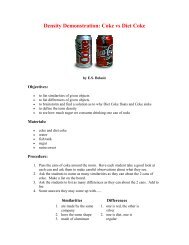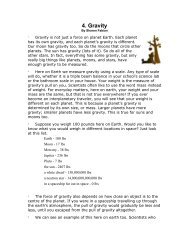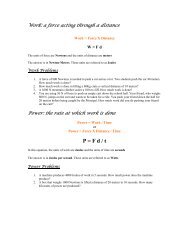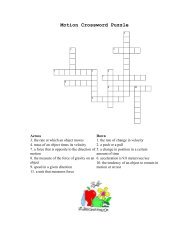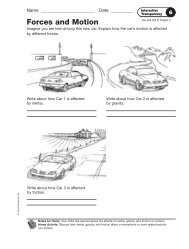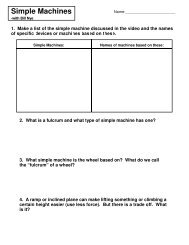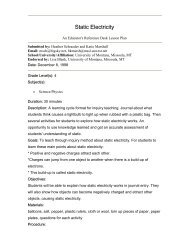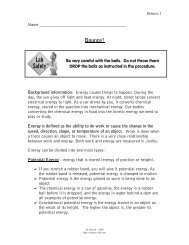5th and 6th Grade Teacher Guide
5th and 6th Grade Teacher Guide
5th and 6th Grade Teacher Guide
Create successful ePaper yourself
Turn your PDF publications into a flip-book with our unique Google optimized e-Paper software.
Experiment with Conductors <strong>and</strong> InsulatorsMaterials:Students will need 1 D-cell battery, 1 1.2-volt lightbulb, 1 matching lightbulb base, one12-inch piece <strong>and</strong> two 4-inch pieces of insulated solid str<strong>and</strong> 18-22 gauge copper wirewith one inch of insulation removed at each end, <strong>and</strong> masking tape. Bulbs, bases, <strong>and</strong>wire can be purchased at stores like Radio Shack. Make sure the lightbulbs <strong>and</strong> basesmatch. Students will also need a variety of things they think might conduct electricity,such as toothpicks, rubber b<strong>and</strong>s, paper clips, plastic, fruit, etc.Safety First:• Students should be supervised by an adult while doing this experiment.• A teacher or another adult should be responsible for stripping insulation fromwires.• Explain to students that electricity can be dangerous if it is not h<strong>and</strong>led correctly,<strong>and</strong> emphasize they should never experiment with the electricity that comes froma wall outlet. It’s much more powerful than the electricity made by small batteries<strong>and</strong> could seriously injure or even kill someone.Experiment Tips:• <strong>Teacher</strong>s should strip the wires ahead of time <strong>and</strong> make sure the batteries arefresh. Though the illustration does not show it, use tape to stick the wires to theends of the battery.• Students are likely to know that metals are good conductors, but they may beunaware that things with a lot of liquids in them also conduct well. Some things tohave on h<strong>and</strong> include lemons, pickles, <strong>and</strong> potatoes. When testing these, makesure students stick wires into the wet part of the item.• The key in the conduction of electricity is the movement of electrons. Metals areelements that freely share electrons. In liquids, dissolved ions can carry a chargeas well. That is why water helps in the conduction of electricity. Salty water,loaded with sodium <strong>and</strong> chloride ions, helps even more.Objective:Students will learn the difference between conductors <strong>and</strong> insulators.Getting it Across:1. Have students bring in things they think might conduct electricity.2. Have teams read the information <strong>and</strong> follow the steps on the page.3. Students should first test their circuit by connecting it without any trial material.Questions <strong>and</strong> Answers:• Ask teams to share their predictions <strong>and</strong> results. Were the results the same? If not,why not? (Answers will vary. Be sure the experimental setup was not at fault.)• What conclusions can students draw about conductors <strong>and</strong> insulators? (Answerswill vary. Students might generalize that metals are good conductors or plastic is agood insulator.)



